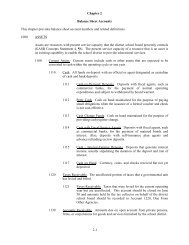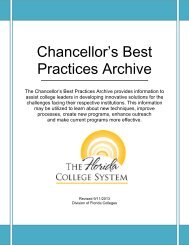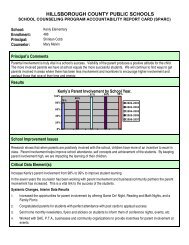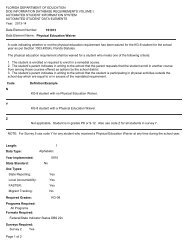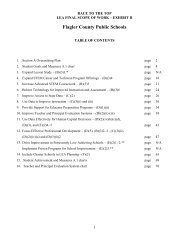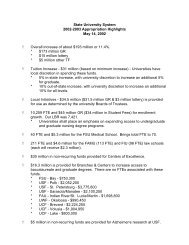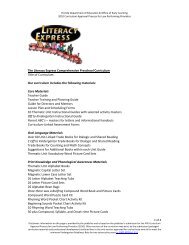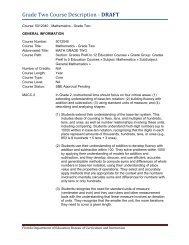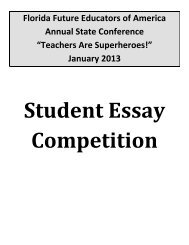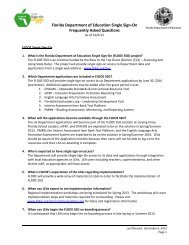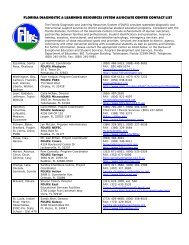Hillsborough County Lessons Learned Presentation
Hillsborough County Lessons Learned Presentation
Hillsborough County Lessons Learned Presentation
Create successful ePaper yourself
Turn your PDF publications into a flip-book with our unique Google optimized e-Paper software.
<strong>Lessons</strong> <strong>Learned</strong>
Communication, Communication, Communication<br />
• Collaborative effort<br />
• Support of all stakeholders<br />
• Teachers, Principals, Supervisors, Students, Parents, Teacher’s<br />
Union, Community<br />
• Transparent Process<br />
• Open two-way dialog<br />
• Multiple methods of distributing and receiving information<br />
• Teachers need to be able to review and verify the students<br />
that count for them and their data multiple times.<br />
Helping students achieve by helping teachers excel
What assessments will be included in the model?<br />
• State testing data mandated.<br />
• Standardized national assessments are readily available.<br />
• When district assessments are used…<br />
– consider the impact on the teacher<br />
• Time to administer vs. quality of the data received<br />
• Is the assessment aligned with the curriculum?<br />
– consider the sample size<br />
• Best practice suggests 10 teachers for a particular course to have<br />
appropriate standard error ranges.<br />
• Consider what will be done with results when the sample size of<br />
teachers is less than 10…less than 3….<br />
– consider the complexity of the assessment<br />
– consider how the data will be recorded and reported<br />
• Item bank/Testing platform<br />
• How will you maintain as much objectivity as possible?<br />
Helping students achieve by helping teachers excel
What assessments will be used for unique<br />
populations?<br />
• How will ESE students be measured?<br />
– We looked at assessments recommended for use with specific populations.<br />
– We are using the Brigance Test of Basic Skills for students in grades KG-2 and<br />
11 & higher and the Battelle and 4 Year Old Standards for PK.<br />
– We also have a district created rubric for assessing life skills in low<br />
prevalence populations.<br />
• How will electives like performing arts be measured?<br />
– Our first round included performance items.<br />
– We moved to written exams based on the content knowledge taught in these<br />
courses.<br />
– We are testing specials on-line at the elementary level.<br />
• Group administration<br />
• Art pictures embedded<br />
• Music recordings<br />
• Paper and pencil option<br />
• What about courses where a teacher has multiple levels in the same section?<br />
• How will the data be captured?<br />
Helping students achieve by helping teachers excel
If district assessments will be used, what measures<br />
will ensure their validity and reliability?<br />
• Content validity<br />
• Test security<br />
• Item bank/testing platform<br />
– Monitor real time data, rescore, rescan, remove zeros<br />
– Conduct an item analysis each time an assessment is administered<br />
– Revise exams if the point biserial and p value indicate a change is needed<br />
• Minimize the use of stand alone pre-tests<br />
– Prior year achievement for Reading and Math<br />
• FCAT, Stanford, PSAT …….<br />
– District semester exam/end of year test from prior year<br />
• Importance to student – exam exemptions<br />
• Large item bank so that multiple versions of the exam can be developed<br />
• District staff dedicated to building exams and better assessments<br />
— Collaborate with curriculum supervisors and teachers<br />
Helping students achieve by helping teachers excel
Revised items are<br />
stored for current or<br />
later use.<br />
Good items are kept<br />
&<br />
Poor items are<br />
revised or deleted<br />
Test Blueprint created by<br />
curriculum supervisors<br />
and teacher leaders* to<br />
include standards and<br />
number of items tested<br />
Developing<br />
and Revising<br />
Assessment<br />
Items or whole test<br />
is field tested<br />
during the year<br />
*Teacher leaders are recommended and approved in conjunction with CTA.<br />
Curriculum<br />
supervisor and<br />
teacher leaders<br />
write and/or select<br />
items and prepare<br />
assessment for field<br />
testing<br />
Assessment is<br />
transferred to<br />
online portal<br />
(Achievement<br />
Series)
How will common exams be created and the autonomy<br />
for teacher decision making be maintained?<br />
• In most courses a common semester exam would be expected and the<br />
norm.<br />
• In cases where no prior exam existed, we created exams for the courses.<br />
– We created ROTC exams.<br />
• In other cases, the design of the course called for flexibility in pacing and<br />
autonomous decision making by the teacher.<br />
– We worked with IB teachers in order to find some common ground.<br />
• In some courses a common exam was easily agreed upon.<br />
• In some courses where pacing was varied, we agreed upon a common set of<br />
questions per topic administered by all in the course of the year.<br />
Helping students achieve by helping teachers excel
How can multiple response formats be<br />
incorporated?<br />
• The majority of exams are multiple choice and scanned into our<br />
Achievement Series database.<br />
• Some assessments are open response (Writing).<br />
– Common scoring rubric<br />
– Scorers trained and calibrated yearly on the rubric<br />
– Teachers do not score the papers of their own students<br />
• Some assessments will be gridded response.<br />
– One example is IB Math Analysis<br />
• Teacher had an excellent open response exam.<br />
• In order to be as objective as possible, exam utilizes a gridded response that can<br />
be evaluated off site.<br />
Helping students achieve by helping teachers excel
• Process<br />
Test Development<br />
• Curriculum supervisors select teachers to work on each test – the<br />
number of teachers varies based on the overall student enrollment.<br />
• The content supervisors are responsible for content validity.<br />
• The assessment department is responsible for item quality and overall<br />
test quality.<br />
• Current course teachers develop a test blueprint based on the course<br />
objectives and teacher consensus.<br />
• The weight of objectives or content on the test is based on the time<br />
that content is addressed in the curriculum. This serves as a proxy for<br />
importance.<br />
• The blueprint includes content and Webb’s cognitive complexity.<br />
• We try to focus on the culminating skills for each semester.
Test Development<br />
• Teacher training in item writing<br />
• We generally require the teachers to submit items for review as part of<br />
the training process.<br />
• Frequently teachers who are excellent in instructional delivery are not<br />
necessarily good at item creation.<br />
• Challenges<br />
• Reliable Platform with authoring capabilities<br />
• Method of scoring – timelines<br />
• Administering and scanning correctly/<br />
• Support staff in place during testing<br />
• Tech support<br />
• Maintaining test security<br />
• Printing costs<br />
• Writing items that measure higher levels of cognitive skills<br />
• Endless process<br />
Helping students achieve by helping teachers excel
Helping students achieve by helping teachers excel<br />
When students succeed, we all win.



